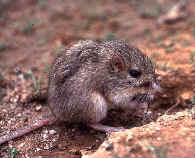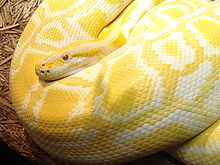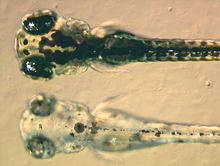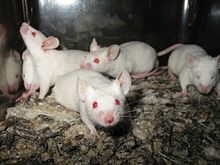
Melanin is a broad term for a group of natural pigments found in most organisms. The melanin pigments are produced in a specialized group of cells known as melanocytes.

Melanocytes are melanin-producing neural crest-derived cells located in the bottom layer of the skin's epidermis, the middle layer of the eye, the inner ear, vaginal epithelium, meninges, bones, and heart. Melanin is a dark pigment primarily responsible for skin color. Once synthesized, melanin is contained in special organelles called melanosomes which can be transported to nearby keratinocytes to induce pigmentation. Thus darker skin tones have more melanosomes present than lighter skin tones. Functionally, melanin serves as protection against UV radiation. Melanocytes also have a role in the immune system.

Chromatophores are cells that produce color, of which many types are pigment-containing cells, or groups of cells, found in a wide range of animals including amphibians, fish, reptiles, crustaceans and cephalopods. Mammals and birds, in contrast, have a class of cells called melanocytes for coloration.

Human hair color is the pigmentation of human hair follicles due to two types of melanin: eumelanin and pheomelanin. Generally, if more melanin is present, the color of the hair is darker; if less melanin is present, the hair is lighter. The tone of the hair is dependent on the ratio of black or brown eumelanin to yellow or red pheomelanin. Levels of melanin can vary over time causing a person's hair color to change, and it is possible to have hair follicles of more than one color on the same person. Some hair colors are associated with some ethnic groups due to observed higher frequency of particular hair color within their geographical region, e.g. straight dark hair amongst East Asians, Southeast Asians, Polynesians and Native Americans, a large variety of dark, fair, curly, straight, wavy and bushy hair amongst Europeans, West Asians and North Africans, curly, dark, and uniquely helical hair with Sub Saharan Africans, whilst gray, white or "silver" hair is often associated with age.

Cat coat genetics determine the coloration, pattern, length, and texture of feline fur. The variations among cat coats are physical properties and should not be confused with cat breeds. A cat may display the coat of a certain breed without actually being that breed. For example, a Neva Masquerade could wear point coloration, the stereotypical coat of a Siamese.

Equine coat color genetics determine a horse's coat color. Many colors are possible, but all variations are produced by changes in only a few genes.

Tyrosinase is an oxidase that is the rate-limiting enzyme for controlling the production of melanin. The enzyme is mainly involved in two distinct reactions of melanin synthesis otherwise known as the Raper Mason pathway. Firstly, the hydroxylation of a monophenol and secondly, the conversion of an o-diphenol to the corresponding o-quinone. o-Quinone undergoes several reactions to eventually form melanin. Tyrosinase is a copper-containing enzyme present in plant and animal tissues that catalyzes the production of melanin and other pigments from tyrosine by oxidation. It is found inside melanosomes which are synthesized in the skin melanocytes. In humans, the tyrosinase enzyme is encoded by the TYR gene.

Chestnut is a hair coat color of horses consisting of a reddish-to-brown coat with a mane and tail the same or lighter in color than the coat. Chestnut is characterized by the absolute absence of true black hairs. It is one of the most common horse coat colors, seen in almost every breed of horse.

Agouti-signaling protein is a protein that in humans is encoded by the ASIP gene. It is responsible for the distribution of melanin pigment in mammals. Agouti interacts with the melanocortin 1 receptor to determine whether the melanocyte produces phaeomelanin, or eumelanin. This interaction is responsible for making distinct light and dark bands in the hairs of animals such as the agouti, which the gene is named after. In other species such as horses, agouti signalling is responsible for determining which parts of the body will be red or black. Mice with wildtype agouti will be grey, with each hair being partly yellow and partly black. Loss of function mutations in mice and other species cause black fur coloration, while mutations causing expression throughout the whole body in mice cause yellow fur and obesity.

A white horse is born predominantly white and stays white throughout its life. A white horse has mostly pink skin under its hair coat, and may have brown, blue, or hazel eyes. "True white" horses, especially those that carry one of the dominant white (W) genes, are rare. Most horses that are commonly referred to as "white" are actually "gray" horses whose hair coats are completely white. Gray horses may be born of any color and their hairs gradually turn white as time goes by and take on a white appearance. Nearly all gray horses have dark skin, except under any white markings present at birth. Skin color is the most common method for an observer to distinguish between mature white and gray horses.

The Sinaloan pocket mouse is one of 17 species of pocket mice in the genus Chaetodipus. Two subspecies of C. pernix are recognized, C. p. pernix and C. p. rostratus, all are endemic to Mexico.

The genetic basis of coat colour in the Labrador Retriever has been found to depend on several distinct genes. The interplay among these genes is used as an example of epistasis.

Tyrosinase-related protein 1, also known as TYRP1, is an intermembrane enzyme which in humans is encoded by the TYRP1 gene.
Oculocutaneous albinism type I or type 1A is an autosomal recessive skin disease. This subtype of oculocutaneous albinism is caused when the gene for tyrosinase does not function properly.

Ocular albinism type 1(OA1) is the most common type of ocular albinism, with a prevalence rate of 1:50,000. It is an inheritable classical Mendelian type X-linked recessive disorder wherein the retinal pigment epithelium lacks pigment while hair and skin appear normal. Since it is usually an X-linked disorder, it occurs mostly in males, while females are carriers unless they are homozygous. About 60 missense and nonsense mutations, insertions, and deletions have been identified in Oa1. Mutations in OA1 have been linked to defective glycosylation and thus improper intracellular transportation.

A melanistic mask is a dog coat pattern that gives the appearance of a mask on the dog's face. The hairs on the muzzle, and sometimes entire face or ears, are colored by eumelanin instead of pheomelanin pigment. Eumelanin is typically black, but may instead be brown, dark gray, or light gray-brown. Pheomelanin ranges in color from pale cream to mahogany. The trait is caused by M264V (EM), a completely dominant allele (form) of the melanocortin 1 receptor gene.

The melanocortin 1 receptor (MC1R), also known as melanocyte-stimulating hormone receptor (MSHR), melanin-activating peptide receptor, or melanotropin receptor, is a G protein–coupled receptor that binds to a class of pituitary peptide hormones known as the melanocortins, which include adrenocorticotropic hormone (ACTH) and the different forms of melanocyte-stimulating hormone (MSH). It is coupled to Gαs and upregulates levels of cAMP by activating adenylyl cyclase in cells expressing this receptor. It is normally expressed in skin and melanocytes, and to a lesser degree in periaqueductal gray matter, astrocytes and leukocytes. In skin cancer, MC1R is highly expressed in melanomas but not carcinomas.

Albinism is the congenital absence of melanin in an animal or plant resulting in white hair, feathers, scales and skin and reddish pink or blue eyes. Individuals with the condition are referred to as albinos.

Dogs have a wide range of coat colors, patterns, textures and lengths. Dog coat color is governed by how genes are passed from dogs to their puppies and how those genes are expressed in each dog. Dogs have about 19,000 genes in their genome but only a handful affect the physical variations in their coats. Most genes come in pairs, one being from the dog's mother and one being from its father. Genes of interest have more than one expression of an allele. Usually only one, or a small number of alleles exist for each gene. In any one gene locus a dog will either be homozygous where the gene is made of two identical alleles or heterozygous where the gene is made of two different alleles.
The agouti gene, the Agouti-signaling protein (ASIP) is responsible for variations in color in many species. Agouti works with extension to regulate the color of melanin which is produced in hairs. The agouti protein causes red to yellow pheomelanin to be produced, while the competing molecule α-MSH signals production of brown to black eumelanin. In wildtype mice, alternating cycles of agouti and α-MSH production cause agouti coloration. Each hair has bands of yellow which grew during agouti production, and black which grew during α-MSH production. Wildtype mice also have light-colored bellies. The hairs there are a creamy color the whole length because the agouti protein was produced the whole time the hairs were growing.























